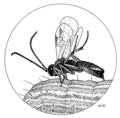Cotesia
| Cotesia | |
|---|---|
| Male C. congregata courting an immobilized female (slow motion) | |
| Male C. congregata courtship song | |
| Scientific classification | |
| Kingdom: | Animalia |
| Phylum: | Arthropoda |
| Class: | Insecta |
| Order: | Hymenoptera |
| Family: | Braconidae |
| Subfamily: | Microgastrinae |
| Genus: | Cotesia Cameron, 1891 |
| Diversity | |
| more than 300 species | |
Cotesia is a genus of braconid wasps first described by Peter Cameron in 1891. Some species parasitize caterpillars of species considered pests, and are used as biocontrol agents. Cotesia congregata parasitizes the tomato and the tobacco hornworms. C. glomerata and C. rubecula feed on the cabbage white and other white butterfly caterpillars. and are host-specific and parasitize the common brimstone.[1]
The wasp parasitizes the caterpillar of the gypsy moth. It, and the gypsy moth, are native to Europe. The gypsy moth is an invasive species in North America, and C. melanoscelus has been imported as a biocontrol of the moth.[2] Cotesia icipe is a parasitoid of Spodoptera littoralis and beet armyworm (Spodoptera exigua) which are pests of amaranth crops.[3]
Species[]

Cotesia ruficrus illustrated by Des Helmore
Cotesia sp. cocoons

Cotesia sp. cocoons
See also[]
References[]
- ^ Lozan, Aurel; Spitzer, Karel; Jaroš, Josef (2012-06-01). "Isolated peat bog habitats and their food connections: parasitoids (Hymenoptera: Ichneumonoidea) and their lepidopteran hosts". Journal of Insect Conservation. 16 (3): 391–397. ISSN 1366-638X. doi:10.1007/s10841-011-9425-4.
- ^ McCullough, Deborah; Raffa, Kenneth; Williamson, R. Chris. "Natural Enemies of Gypsy Moth: The Good Guys!" (PDF). Entomology University of Wisconsin. Michigan State University Extension. Archived from Manuals/McCullough.Raffa.Williamson.GypsyMothGoodGuys.pdf the original Check
|url=value (help) (PDF) on 17 June 2010. Retrieved 18 April 2019. - ^ "Fiaboe KKM, Fernández-Triana J, Nyamu FW, Agbodzavu KM (2017) Cotesia icipe sp. n., a new Microgastrinae wasp (Hymenoptera, Braconidae) of importance in the biological control of Lepidopteran pests in Africa. Journal of Hymenoptera Research 61: 49–64. DOI 10.3897/jhr.61.21015". doi:10.3897/jhr.61.21015. Cite journal requires
|journal=(help)
External links[]
- Preliminary evolutionary relationships within the parasitoid wasp genus Cotesia
- Moisset, Beatriz (February 18, 2017). "Genus Cotesia". BugGuide. Retrieved January 4, 2019.
- Hymenoptera Institute. U. Kentucky
- Microgastrinae
- Braconidae genera
- Ichneumonoidea stubs



